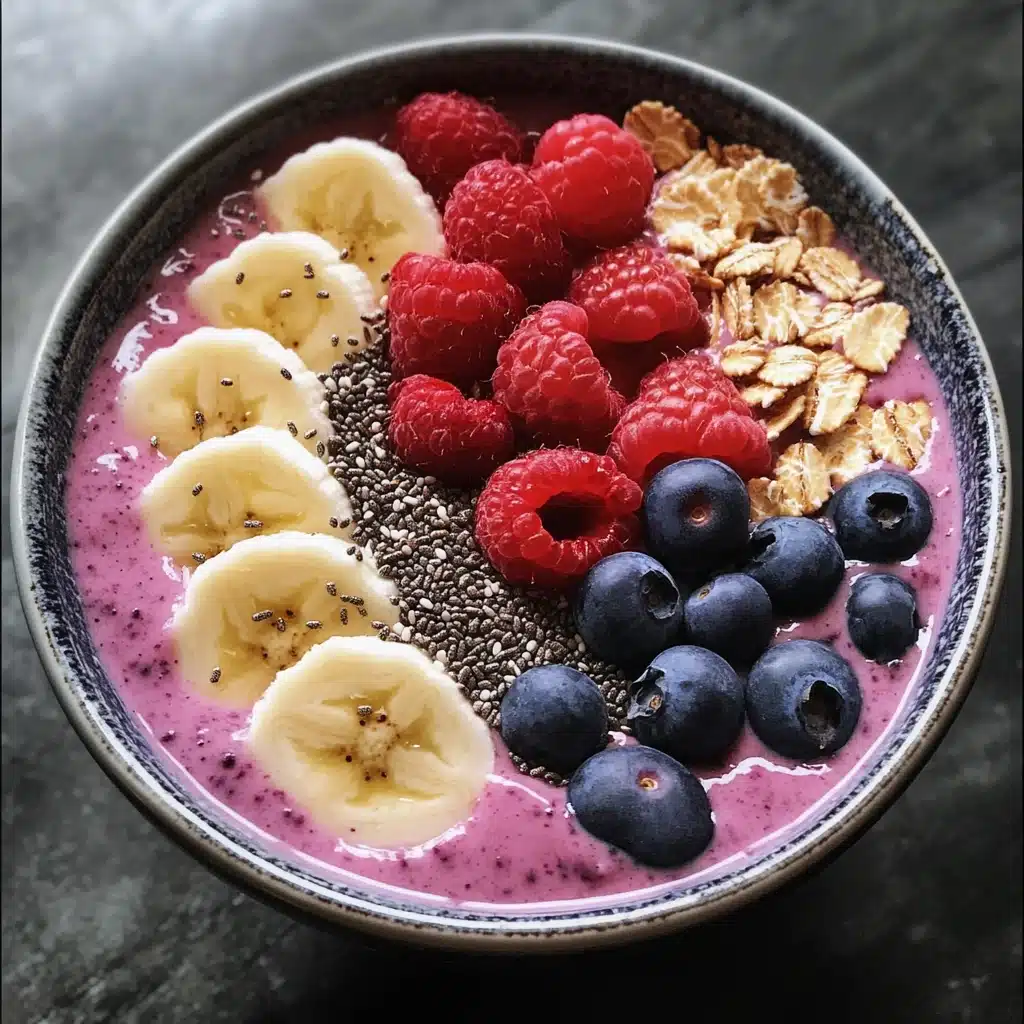Introduction
Did you know that 59% of Americans skip breakfast at least once a week, despite it being considered the most important meal of the day? What if there was a breakfast option that’s not only nutritious but also Instagram-worthy and customizable to your exact preferences? Enter smoothie bowls – the breakfast revolution that’s transforming morning routines worldwide. These vibrant, nutrient-packed creations offer everything from sustained energy to gut health benefits, all while being infinitely adaptable to your taste preferences and dietary needs.
What Are Smoothie Bowls?
Smoothie bowls are essentially thicker versions of traditional smoothies, served in a bowl and topped with a variety of nutritious ingredients. Unlike drinkable smoothies, these bowls are meant to be eaten with a spoon, creating a more satisfying, meal-like experience. The beauty of smoothie bowls lies in their versatility – they can be customized to support virtually any health goal or dietary preference, from high-protein fitness bowls to antioxidant-rich immunity boosters.
Base Ingredients for Perfect Smoothie Bowls
Creating the perfect smoothie bowl starts with selecting the right base ingredients. The ideal bowl has a thick, creamy consistency that can support toppings without them sinking to the bottom. Here’s what you’ll need:
- Frozen fruits (1-1.5 cups) – Bananas, berries, mango, or pineapple provide natural sweetness and the perfect thick consistency
- Liquid base (1/4-1/3 cup) – Less than you’d use for a drinkable smoothie; try almond milk, coconut water, or yogurt
- Protein source (optional, 1-2 tablespoons) – Greek yogurt, protein powder, or nut butter
- Thickeners (optional, 1-2 tablespoons) – Chia seeds, flaxseeds, oats, or avocado
- Superfoods (optional, 1 teaspoon) – Spirulina, matcha, cacao, or maca powder
- Natural sweeteners (optional, to taste) – Honey, maple syrup, or dates
Timing
One of the major advantages of smoothie bowls is their efficiency. The average preparation time is just 10 minutes – that’s 75% faster than traditional cooked breakfast options like pancakes or omelets. Even better, no cooking is required! This breakdown will help you plan your morning:
- Preparation time: 5-7 minutes (for washing, peeling, and cutting non-frozen ingredients)
- Blending time: 2-3 minutes (including pauses to scrape down sides and adjust thickness)
- Assembly/decoration time: 1-2 minutes (for arranging toppings)
- Total time: 8-12 minutes
Step-by-Step Instructions
Follow these simple steps to create your perfect smoothie bowl masterpiece:
Step 1: Prepare Your Fruits
If using fresh fruits instead of pre-frozen, slice them and freeze for at least 4 hours or overnight. Pro tip: Freezing overripe bananas is perfect for smoothie bowls – they’re sweeter and more economical than using fresh ones. For the creamiest texture, ensure at least 50% of your fruit ingredients are frozen.
Step 2: Add Base Ingredients to Blender
Place frozen fruits at the bottom of your blender, followed by your liquid of choice. Remember: the key to a perfect smoothie bowl is using significantly less liquid than you would for a drinkable smoothie – start with just 1/4 cup and add more only if necessary. Add any protein sources, thickeners, or superfood powders at this stage.
Step 3: Blend Strategically
Use the pulse function on your blender first to break down larger frozen pieces, then blend on low speed, gradually increasing to medium. Avoid high speed as it can warm the mixture and create a thinner consistency. Pause frequently to scrape down the sides with a spatula. A high-powered blender will create the smoothest results, but any blender can work with proper technique.
Step 4: Achieve the Perfect Consistency
Your smoothie bowl base should be thick enough that a spoon drawn through it leaves a visible path. If it’s too thick to blend properly, add tiny amounts of liquid (1 tablespoon at a time). If it’s too thin, add more frozen fruit, a handful of ice, or a thickening agent like chia seeds.
Step 5: Transfer and Top
Pour your smoothie base into a wide, shallow bowl that allows ample surface area for toppings. Work quickly as the mixture will start to melt. Arrange your toppings in organized sections for visual appeal, or simply sprinkle them across the entire surface.
Nutritional Information
The nutritional profile of smoothie bowls varies widely depending on ingredients, but a standard bowl offers impressive benefits. A basic berry and banana smoothie bowl with yogurt and granola typically contains:
- Calories: 350-450 calories
- Protein: 8-15g (16-30% of daily needs)
- Fiber: 7-12g (25-43% of daily needs)
- Vitamins: Often provides 100%+ of daily Vitamin C needs, plus significant amounts of A, E, and K
- Antioxidants: Research shows berries contain some of the highest antioxidant levels of any foods
- Prebiotics: 4-6g from fruits and toppings like seeds and oats
Studies indicate that consuming fruit-based breakfasts like smoothie bowls can lead to better blood sugar control throughout the day compared to grain-based breakfasts of equivalent calories.
Healthier Alternatives for the Recipe
Customize your smoothie bowl to meet specific dietary goals with these modifications:
- Lower sugar option: Use 1/2 avocado and 1/2 cup berries instead of banana, add a dash of stevia instead of honey, and include a tablespoon of lemon juice to brighten flavors
- Higher protein version: Add 1 scoop (20-25g) of protein powder, replace fruit-based toppings with nuts and seeds, and use Greek yogurt as part of your liquid base
- Keto-friendly adaptation: Focus on avocado, coconut cream, and berries (in moderation) with MCT oil, topped with unsweetened coconut flakes and hemp seeds
- Dairy-free option: Use coconut yogurt or silken tofu for creaminess, and select plant-based protein powders
- Gut-health booster: Add 1 tablespoon of prebiotic fiber (like inulin), 2 tablespoons of ground flaxseed, and top with kefir instead of milk
Serving Suggestions
Elevate your smoothie bowl experience with these creative serving ideas:
- Tropical vacation bowl: Serve in a hollowed-out pineapple half for an Instagram-worthy presentation
- Dessert replacement: For evening cravings, create a chocolate smoothie bowl with cacao, banana, and a dollop of almond butter, topped with a few dark chocolate shavings
- Meal prep option: Prepare smoothie bases in advance and freeze in silicone muffin cups; blend 4-5 frozen “pucks” with minimal liquid for an instant bowl
- Toppings bar: For family breakfasts, set up a DIY toppings station with small bowls of various options, allowing everyone to personalize their creation
- Seasonal adaptations: Match your toppings to seasonal availability – fresh berries in summer, apple and cinnamon in fall, citrus in winter, and stone fruits in spring
Common Mistakes to Avoid
Sidestep these pitfalls to ensure your smoothie bowl success:
- Mistake 1: Using too much liquid. This creates a runny bowl where toppings sink. Solution: Start with half the liquid you think you need and add more gradually.
- Mistake 2: Blending too long. Extended blending generates heat that melts frozen ingredients. Solution: Use pulse function and brief blending intervals.
- Mistake 3: Nutrient imbalance. Many bowls are high in fruit sugars but low in protein and healthy fats. Solution: Always include a protein source and a healthy fat to balance blood sugar response.
- Mistake 4: Topping overload. Adding too many calorie-dense toppings can turn a healthy breakfast into a 700+ calorie meal. Solution: Limit to 3-4 tablespoons of toppings total.
- Mistake 5: Forgetting texture contrast. Soft toppings on soft smoothie creates a monotonous eating experience. Solution: Include at least one crunchy element like granola, nuts, or seeds.
Storing Tips for Smoothie Bowls
Smoothie bowls are best enjoyed immediately after preparation, but if needed, these storage strategies can help:
- Short-term storage (up to 2 hours): Place in refrigerator with a layer of plastic wrap directly on the surface to prevent oxidation
- Prepare-ahead components: Store blended base and toppings separately; the base can be refrigerated for up to 24 hours in an airtight container
- Freezer method: Pour prepared smoothie base into ice cube trays and freeze; re-blend 6-8 cubes with a splash of liquid when ready to eat
- Topping preservation: Store cut fruit toppings in water with a squeeze of lemon juice to prevent browning
Conclusion
Smoothie bowls represent more than just a breakfast trend – they’re a customizable nutrition strategy that can adapt to your changing needs and preferences. With endless flavor combinations, significant health benefits, and visual appeal that makes healthy eating exciting, they truly deserve their place in the breakfast revolution. Whether you’re looking to boost your morning nutrition, save time on busy days, or simply enjoy a delicious start to your day, smoothie bowls offer a solution that’s as practical as it is delightful. Why not create your signature bowl tomorrow morning?
FAQs
Can smoothie bowls help with weight management?
Yes, when properly balanced. Research shows meals containing fiber, protein, and healthy fats promote satiety and can reduce overall daily calorie intake. To make your smoothie bowl weight-management friendly, include protein (15-20g), healthy fats like avocado or nut butter, and limit high-calorie toppings to 3-4 tablespoons total. Studies indicate that front-loading calories at breakfast may actually support weight management better than skipping breakfast.
Are smoothie bowls suitable for children?
Absolutely! Smoothie bowls can be an excellent way to incorporate fruits, vegetables, and nutrients into children’s diets. For kids, consider using more milk or yogurt for added calcium, reduce superfood powders which may have strong flavors, and involve them in the decoration process. Research shows that children are more likely to eat foods they’ve helped prepare, making smoothie bowls an interactive way to encourage healthy eating habits.
Can I make a smoothie bowl without a high-powered blender?
Yes, though you’ll need to adjust your technique. With a standard blender, try these approaches: cut frozen fruits into smaller pieces before freezing, add slightly more liquid, blend in smaller batches, and use the pulse function frequently while scraping down the sides. You can also partially thaw frozen fruits for 5-10 minutes before blending. Many successful smoothie bowl enthusiasts use standard blenders – it just requires a bit more patience.
How can I ensure my smoothie bowl keeps me full until lunch?
The satiety power of your smoothie bowl depends on its macronutrient balance. To create a truly filling bowl, include at least 15-20g protein (e.g., Greek yogurt, protein powder), healthy fats (avocado, nut butter, seeds), and fiber-rich ingredients. Research from the American Journal of Clinical Nutrition suggests that meals containing this trifecta of nutrients can extend satiety for 4+ hours. Also consider adding a tablespoon of oats or chia seeds, which expand in your stomach and promote fullness.
Can smoothie bowls be part of a diabetic-friendly diet?
With careful construction, smoothie bowls can be adapted for blood sugar concerns. Clinical nutritionists recommend: limiting fruit to 1 cup total (prioritizing berries which have a lower glycemic impact), including protein and fat sources, adding cinnamon (which has been shown to moderate blood sugar response), and incorporating fiber-rich toppings like flaxseed. Always monitor your individual response, as everyone’s glucose reaction differs. Consulting with a healthcare provider for personalized guidance is recommended.

